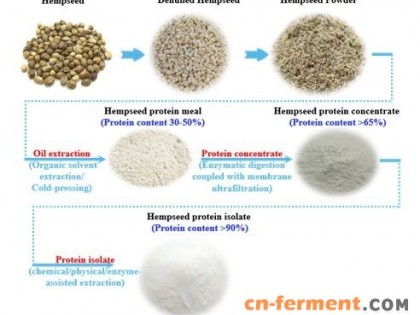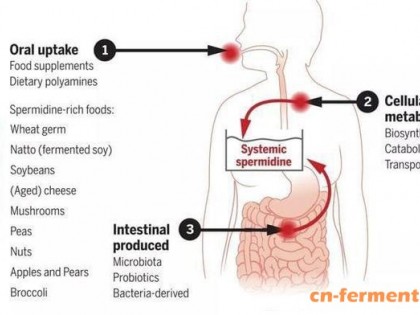2. College of Life Sciences, Hubei Normal University, Huangshi, Hubei 435002, China ;
3. College of Food Science and Technology, Huazhong Agricultural University, Wuhan, Hubei 430070, China
红曲菌(Monascus sp.),又称红曲霉,是我国传统特色的药食两用微生物资源。其以米饭为培养基质的固体发酵产品——红曲,在我国及东南亚地区作为食品着色剂、发酵剂以及中药配伍等已有上千年的应用历史[1-2]。现代研究表明,红曲菌可产生红曲色素(Monascus pigments,MPs)、莫纳可林K (monacolin K,MK)、γ-氨基丁酸、dimerumic acid等有益代谢产物。但是,部分红曲菌还可产生真菌毒素——桔霉素(citrinin)[3-6]。如何促进MPs和MK等有益产物的产生,消除或控制桔霉素的产生,已经成为当前红曲菌研究的热点。
MPs是红曲菌产生的主要代谢产物之一,它通常是由红色素、黄色素和橙色素等3类色素组成的混合物[7]。MPs是我国食品添加剂使用标准(GB2760-2014)中为数不多的由微生物发酵生产的天然色素之一,该标准中允许使用的红曲类产品主要包括红曲红色素、红曲黄色素及红曲米粉。近年来,作为天然食品着色剂,MPs的市场需求量逐年递增,年增长率可达5%-10%。MPs除作为食品着色剂外,还可部分替代肉品加工中所用的亚硝酸盐[8],MPs还可用于皮革和棉布等的染 色[9-10]以及太阳能电池的制备等[11-12]。然而,将红曲米粉直接用作着色剂时,存在溶解性差及因色价相对较低导致使用量较大等问题;以液态发酵法生产并提纯后的MPs为着色剂时效果较好,但成本偏高。因此,提高液态发酵产MPs的产量并降低生产成本,成为该产业急需解决的关键问题之一。
关于MPs的生产,由于传统固态发酵方法存在发酵周期长、工作量大、生产的色素直接使用时因均一度不好需提纯后使用等问题,使其发展受到一定的限制。而液态发酵则具有便于管理、发酵周期短、成本较低且产品质量高等优点,成为生产MPs的主要方法,具有广阔的发展前景[13]。然而,液态发酵生产MPs也存在原料转化率及产量较低、色素水溶性差等缺点。碳源作为液态发酵的主要原料,研究其利用及转化的机制对提升原料转化率、降低MPs的生产成本具有重要意义。
甘油,又叫丙三醇,是微生物的常用碳源。其主要来源包括以天然油脂为原料生产的甘油即天然甘油、由丙烯合成的甘油即合成甘油以及微生物发酵生产的甘油。近年来,生物柴油产业发展迅速,但每生产10 t生物柴油即可产生约1 t的粗甘油[14],粗甘油的综合利用成为制约该产业发展的关键问题之一。作为解决甘油综合利用的重要途径,甘油的生物转化成为近年来研究的热点。甘油作为微生物可利用碳源,与其它常用碳源如葡萄糖、乳糖、淀粉等相比,不仅价格相对低廉,且在微生物发酵过程中未发现如葡萄糖等快速利用碳源常见的代谢阻遏现象[15]。
研究表明,多种微生物都可以利用甘油产生高附加值的产品。例如,醋酸梭状芽胞杆菌(Clostridium butyricum)、畸雌腐霉(Pythium irregulare)、裂殖壶菌(Schizochytrium limacinum)、假单胞菌(Pseudomonas oleovorans)、大肠埃希氏菌(Escherichia coli)和酿酒酵母(Saccharomyces cerevisiae)可以将甘油分别转化为1,3丙二醇(Propanediol,PDO)、二十碳五烯酸(Eicosapntemacnioc acid,EPA)和二十二碳六烯酸(Docosahexaenoic acid,DHA)、聚羟基脂肪酸酯 (Polyhydroxyalkanoates,PHA)、乳酸、乙醇等[16-18]。已有研究表明,甘油不仅可被红曲菌利用,还可促进MPs的产生。本文将就相关的研究进行综述,并对其作用机制进行分析。
1 甘油对红曲菌发酵产MPs的影响 1.1 红曲菌液态发酵产MPs的常用碳源红曲菌液态发酵生产MPs的常用碳源主要包括葡萄糖、乳糖、果糖、麦芽糖、乙醇、甘油、淀粉等[19-22]。葡萄糖及其寡糖、多糖与果糖相比更利于红曲菌(Monascus sp. TTWMB 6042)的生长及MPs的产生[23]。不同的碳源还可影响所产生MPs的组分,当以麦芽糖和葡萄糖为碳源时,紫色红曲菌(M. purpureus)主要产生咖啡色色素,当以蔗糖为碳源时则产生颜色较亮的MPs[20],且与葡萄糖相比,麦芽糖更利于紫色红曲菌产红曲红胺[21]。与上述碳源相比,甘油价格相对较低,且未见甘油在微生物代谢过程中碳源代谢阻遏现象的相关报道[24],具有潜在的研究及开发价值。
1.2 甘油对红曲菌发酵产MPs的影响以丛毛红曲菌(M. pilosus) MS-1为发酵菌株,考察向培养基中添加甘油对MS-1产色素的影响,以不添加甘油的处理作为对照。向液态培养基中添加2 g/L甘油即可显著提高其MPs产量,甘油添加量达10 g/L时可显著增加MS-1生物量;甘油添加量达40 g/L时,发酵液色价达到最高13.78 U/mL,是对照的7.6倍。当甘油添加量为40 g/L和300 g/L时,产MPs调节基因的表达量分别是对照的17.31和22.22倍;产MPs结构基因的表达量分别是对照的33.27和60.07倍[25]。这与文献报道的以甘油为碳源时可促进MPs的产生并提升红曲菌的生物量相一致,添加甘油并不仅仅是提升培养基中的渗透压,还作为一种重要的碳源参与红曲菌的代谢[26]。有研究表明,当红色红曲菌(Monascus ruber)以甘油为唯一碳源时,甘油添加量达40-70 g/L时,MPs产量最高(7.38 U/mL,发酵终点以生物量恒定但色价下降界定)[27]。血红红曲菌(M. sanguineus)在甘油添加量为64 g/L时,MPs产量可达 26.98 U/mL (OD510,培养16 d)[28]。相似条件下,添加0.5 mol/L甘油(46 g/L)时,血红红曲菌的MPs产量可达33.4 U/mL,而紫色红曲菌的MPs产量可达36.7 U/mL (OD510,培养16 d)[29]。另外,也有学者将生物柴油副产物的粗甘油和葡萄糖作为碳源直接用于红曲发酵,发酵60 h红色素产量可达 8.28 U/mL[15]。由文献[25-28]可知,以甘油为唯一或辅助碳源时,至少3个种属的红曲菌表现出产色素能力的显著提高,且培养基中甘油含量为40-70 g/L时产量达到最高。然而,甘油促进红曲菌产色素的作用机制仍不清楚,该领域的深入研究可为后续开展有关甘油综合利用以及红曲色素生产调控提供理论支持。
2 红曲菌对甘油的转化与利用机制分析 2.1 微生物转化与利用甘油的基本途径作为碳源和能源物质,甘油可部分形成生物量,其余则通过氧化和还原两条平行路径代谢,产生多种代谢产物。通过氧化路径,甘油首先在甘油激酶的作用下转化为3-磷酸甘油,再在甘油脱氢酶(GDH)的作用下生成二羟基丙酮,二羟基丙酮在ATP以及二羟基丙酮激酶的作用下生成磷酸二羟基丙酮,磷酸二羟基丙酮可再次代谢生成丙酮酸,并通过乙酰辅酶A进入三羧酸循环或生成其它的小分子酸、醇等产物。氧化途径可生成生物能ATP以及还原当量NADH+H+,并伴随微生物细胞的生长。还原路径的代谢主要包括首先在甘油脱水酶(GDHt)以及辅酶B12的存在下将甘油转化为3-羟基丙醛(3-HPA),在NADH+H+和1,3-丙二醇氧化还原酶(PDOR)的存在下,3-HPA可生成1,3-丙二醇(PDO)。另外,还原途径可消耗氧化途径产生的过量NADH+H+,使微生物细胞内还原物质达到平衡,具体见图 1[30-31]。
 |
| 图 1 甘油的基本代谢途径[30-31] Figure 1 The basic metabolic pathway of glycerol[30-31] |
|
图选项
|
影响甘油代谢最主要的4种酶分别为甘油脱氢酶、甘油脱水酶、二羟基丙酮激酶和1,3-丙二醇氧化还原酶。研究表明,编码这4种酶的基因都位于二羟基丙酮的调节子即dha调节子上,该调节子主要由以下几部分组成,甘油脱氢酶、甘油脱水酶、1,3-丙二醇氧化还原酶和二羟基丙酮激酶以及1个调节基因即dhaR,这4种酶的主要特征如表 1所示[32]。
| 酶 Enzyme |
基因 Gene |
激活因子 Reactivator |
抑制因子 Inhibitor |
| 甘油脱氢酶 Glycerol dehydrogenase |
dhaD | Mn2+,Mg2+,K+,NH4+ | Zn2+,Fe2+,O2 |
| 二羟基丙酮激酶 Dihydroxyacetone kinase |
dhaK | Mg2+,Ca2+ | |
| 甘油脱水酶 Glycerol dehydratase |
dhaB,C,E | K+,NH4+,Rb+ | |
| 1,3-丙二醇氧化还原酶 1,3-Propylene glycol oxide reductase |
dhaT | Mn2+,Fe2+ | O2 |
已知的文献显示,只有肺炎克雷伯杆菌(Klebsiella pneumoniae) MGH 78578和产气荚膜梭菌(Clostridium perfringens)具有完整的dha调节子,肺炎克雷伯杆菌中dha调节子及相关基因如图 2所示[33]。其中dhaR基因在肺炎克雷伯杆菌中对dhaT基因具有正调控作用[34]。然而,甘油代谢产物的浓度和甘油代谢酶的表达量并不是完全呈正相关。当甘油脱水酶的表达量提高时,甘油代谢产物的转化率及浓度并无显著提高,这主要是因为4种关键酶即甘油脱氢酶、二羟基丙酮激酶、甘油脱水酶和1,3-丙二醇氧化还原酶均由dha调节子调控,且中间代谢产物3-HPA对dha调节子的表达和细胞生长都有抑制作用[34]。另外,还有研究表明,在沃氏嗜盐富饶菌(Haloferax volcanii)中,敲除编码甘油激酶(可使甘油转化为3-磷酸甘油)基因glpK后,菌株无法在含有甘油的培养基上生长。甘油激酶的含量在含有甘油的培养基中比不含甘油的培养基中要高。该研究还证实甘油对葡萄糖的代谢有一定的抑制作用[35]。鉴于此,研究甘油与其它碳源代谢之间的关系,以及甘油对微生物碳代谢关键酶及关键基因表达量的影响,可为后期有效调控甘油的代谢奠定基础。
 |
| 图 2 伯杆菌中dha 调节子及相关基因[33] Figure 2 dha regulon and related genes in Klebsiella pneumoniae[33] |
|
图选项
|
可通过检测甘油代谢关键酶的酶活,考察甘油被微生物利用的情况[36],主要测定甘油脱氢酶、甘油脱水酶以及1,3-丙二醇氧化还原酶的酶 活[37-39]。但是,红曲菌对甘油的利用是否也是通过上述关键酶对其逐步水解并产生相关产物?红曲菌中哪些基因对甘油代谢起主要作用?这些问题并不清楚。另外,甘油对红曲菌产MPs的促进作用到底是由于红曲菌在发酵过程中可产生大量甘油代谢关键酶,进而提升了甘油利用率和代谢产物的产量?还是甘油的存在对红曲菌碳代谢相关基因表达有促进作用?均需进一步深入研究。
2.2 红曲菌转化与利用甘油的相关机制分析2.2.1 由代谢产物水平分析红曲菌转化与利用甘油的机制:有研究表明,葡萄糖对MK的生物合成具有抑制效应[40-41],而次级代谢产物往往都是在菌体处于碳代谢饥饿情况下产生的,在利用快速碳源如葡萄糖的同时,加入非抑制碳源,如甘油,可以在菌体生长过程完成后仍保持碳代谢的饥饿状态,进而促进MPs的积累[15, 24]。另一研究也证明了碳饥饿现象的存在,当以劣质碳源如大米作为紫色红曲菌YY-1的碳源时,可促进MPs的产生,推测原因可能是对劣质碳源的利用,导致碳饥饿胁迫,促进了乙酰辅酶A的积累,进而促进了MPs的合成[42]。虽然甘油可促进MPs的产生,但当甘油添加量过高时,可能导致渗透性应激,从而抑制菌体生长和MPs的产生[28, 43]。当甘油浓度较低时,能促进菌体生长及色素积累,这可能是甘油作为碳源所起的作用[44]。关于甘油在红曲菌中的代谢机制仍不清楚,只有极少文献中提到红曲菌可利用甘油产生NADH,进而合成聚酮化合物[45]。
2.2.2 由基因水平分析可能参与红曲菌代谢甘油的相关基因:(1) G蛋白信号及cAMP-PKA通路中碳源代谢相关基因。近年来,G蛋白信号途径在丝状真菌的生长、分化、繁殖、次生代谢以及致病性等方面的调控作用已经得到证实,如构巢曲霉(Aspergillus nidulans)、粗糙脉孢菌(Neurospora crassa)等模式真菌;板栗疫病菌(Cryphonectria parasitica)、稻瘟菌(Magnaporthe grisea)等植物病原菌;烟曲霉(A. fumigatus)等人类致病菌以及红色红曲菌(M. ruber)等工业真菌[46]。丝状真菌可通过G蛋白偶联系统的异三聚体G蛋白(Heterotrimeric G protein,G蛋白)的第III类群Ga亚基感应碳源,将信号传递给下游的cAMP (Cyclic adenosine monophosphate,环磷酸腺苷)信号通路,进一步激活孢子萌发、生长、分化、有性繁殖等生理过程。普遍认为,G-蛋白偶联受体感应到葡萄糖可激活腺苷酸环化酶,将ATP转化为cAMP,cAMP的积累可激活蛋白激酶A (Protein kinase A,PKA)进而对下游目标物进行磷酸化,调节各种生理功能,细胞内cAMP的浓度受cAMP磷酸二酯酶的调控[47]。Lafon等[48]研究发现,α亚基GanB与Gβ亚基SfaD和Gγ亚基GpgA组成的异三聚体G蛋白GanB-SfaD-GpgA可通过感应碳源刺激,促使胞内cAMP迅速升高,引起孢子萌发。此外,ganB基因可能还参与了除葡萄糖之外的其它碳源如甘油、半乳糖、乙醇和果糖等的感应。构巢曲霉中由碳源感应的孢子萌发分子机制模型如图 3所示[48]。G蛋白的第I类群Ga亚基GAN-1也可与粗糙脉孢菌(Neurospora crassa)的G蛋白偶联受体Gpr-4 (NcGpr-4)作用,调控碳源感应[49]。研究表明,在含甘油的培养基中,△gpr-4的生物量减少,且将其转移至葡萄糖为碳源的培养基后cAMP含量并未升高,而粗糙脉孢菌野生菌株却检测到cAMP的水平升高。李利等[50-53]研究发现,第I类Ga亚基Mga1、Mgb1(Gβ)和Mgg1(Gγ)组成的异三聚体G蛋白对MPs以及桔霉素的产生均有重要调控作用。敲除基因Mga1、Mgb1和Mgg1之后,MPs和桔霉素产量显著升高,过表达上述3个基因后则MPs产量无变化而桔霉素却显著降低。通过Mga1的活化突变(Mga1G42R)和外源cAMP实验证实Mga1可通过cAMP-PKA途径实现对MPs及桔霉素的调控作用。关于外源cAMP对红曲菌合成MPs、MK和桔霉素的影响,与已有的研究类似,即高浓度(10 mmol/L) cAMP对红曲菌合成MPs有抑制作用[47]。
 |
| 图 3 构巢曲霉中由碳源调节的孢子萌发早期分子机制模型[48] Figure 3 Proposed model depicting the molecular mechanisms regulating the early events of germination by carbon source sensing in Aspergillus nidulans[48] |
|
图选项
|
(2) 碳代谢阻遏因子——CreA。creA基因可编码介导碳代谢产物阻遏的转录抑制因子CreA[54],该基因于1994年被克隆和测序[55]。creA可通过抑制特殊调节基因如乙醇代谢调节基因alcR或直接抑制结构基因介导碳代谢产物阻遏。它主要通过阻止正调控转录因子如代谢途径中的特殊因子或者一些常规转录因子[56]。有研究表明,在构巢曲霉(A. nidulans)中,CreA通过抑制合成木聚糖降解酶的转录激活因子XlnR,进而间接抑制木聚糖降解酶合成基因xlnA (编码木聚糖酶X22)和xlnB (编码木聚糖酶X24)的转录。creA缺失菌株可解除xlnR基因促进剂的抑制,而xlnR的去抑制可彻底解除xlnA和xlnB的葡萄糖抑制[57]。CreA对alc调节子(构巢曲霉利用乙醇等碳源的关键基因)具有重要的调节作用,它可以抑制乙醇代谢关键基因alcA[58]。综上,CreA对微生物碳源代谢关键酶以及碳源代谢具有多向调节作用[59]。然而,creA基因缺失菌株往往表现出生长缺陷且不适于工业化蛋白的生产,反义沉默基因技术可在不影响真菌生长及菌落形态的前提下,实现葡萄糖抑制的部分解除[60]。该研究反义表达部分编码CreA的基因,结果表明在葡萄糖存在的前提下,葡萄糖可抑制的酶类产量在胞内及胞外均有所提高,且去抑制作用约为creA缺失菌株的一半。已有研究表明,甘油可促进红曲菌产色素,且甘油为非葡萄糖抑制碳源[15, 24-25],而creA基因与葡萄糖抑制关系密切。可通过研究该基因在红曲菌碳代谢过程中的作用以及甘油对该基因的表达和葡萄糖利用影响,探究甘油对红曲菌碳代谢的影响,也为阐明甘油促进红曲菌产色素的分子机理提供参考。
(3) 其它碳代谢相关基因。除上述碳代谢相关基因外,还有一些和碳源利用相关的基因被报道。如构巢曲霉中乙酸代谢相关基因facA[61]、调节编码磷酸烯醇丙酮酸盐羧基激酶的葡萄糖异生基因acuF、编码果糖-1,6-二磷酸酶基因acuG基因表达的acuK和acuM基因等,它们可通过对糖异生相关基因的调控,进而重组碳代谢[62]。另外,在稻瘟病菌中还发现3个碳源代谢的调节基因即tps1、nmr1-3和mdt1,它们编码的蛋白可控制葡萄糖的利用并干扰感染的进程[63]。目前,有关红曲菌碳代谢相关基因的研究较少,可参考已开展深入研究的真菌如构巢曲霉等的碳代谢基因,验证红曲菌中是否存在类似碳代谢基因。对证实存在的碳代谢关键基因进行功能验证,进而探究这些关键基因与红曲菌碳利用乃至代谢产物积累之间的关系。
3 展望作为常用且相对廉价的微生物可利用碳源,甘油的综合利用具有广阔的发展前景。甘油在细菌及酵母中的代谢已有较为深入的研究。虽有研究表明红曲菌可较好地利用甘油为碳源,且可显著促进其主要次生代谢产物如MPs产生,但有关红曲菌代谢甘油的路径研究较少。红曲菌是以何种方式利用甘油以及甘油如何促进其产MPs的机制均不清楚。目前,在基因水平上对红曲菌进行碳代谢的研究较少,虽已证实有大量基因与丝状真菌甚至是红曲菌碳代谢有关,但甘油在丝状真菌中代谢的关键基因仍不明确且鲜有报道。因此,可在甘油对红曲菌的生物量及其它碳源的利用率、碳代谢关键酶类如糖原合酶、葡萄糖激酶等的分泌量、葡萄糖碳代谢阻遏等方面的影响展开研究。同时,分析与甘油等碳源代谢相关调节基因如碳代谢阻遏基因creA、编码糖原合酶基因gsn等关键基因的转录情况,并对红曲菌中存在的碳代谢关键基因进行功能验证,进而探讨甘油影响红曲菌产MPs的分子机理。上述研究可为甘油在红曲发酵产色素方面的利用提供理论支持,也可为甘油的综合利用提供新的思路。
| [1] | Shi YC, Pan TM. Beneficial effects of Monascus purpureus NTU 568-fermented products: a review[J]. Applied Microbiology and Biotechnology , 2011, 90 (4) : 1207–1217. DOI:10.1007/s00253-011-3202-x |
| [2] | Chen WP, He Y, Zhou YX, et al. Edible filamentous fungi from the species Monascus: early traditional fermentations, modern molecular biology, and future genomics[J]. Comprehensive Reviews in Food Science and Food Safety , 2015, 14 (5) : 555–567. DOI:10.1111/crf3.2015.14.issue-5 |
| [3] | Blanc PJ, Loret MO, Goma G. Production of citrinin by various species of Monascus[J]. Biotechnology Letters , 1995, 17 (3) : 291–294. DOI:10.1007/BF01190639 |
| [4] | Hong SH, Lee I, Kim SJ, et al. Improved functionality of soft soybean curd containing Monascus fermented soybean ethanol extract[J]. Food Science and Biotechnology , 2012, 21 (3) : 701–707. DOI:10.1007/s10068-012-0091-4 |
| [5] | Liu MT, Li JJ, Shang XY, et al. Structure elucidation and complete NMR spectral assignment of an unusual aromatic monacolin analog from Monascus purpureus-fermented rice[J]. Mgnetic Resonance in Chemistry , 2011, 49 (3) : 129–131. DOI:10.1002/mrc.v49.3 |
| [6] | Cheng MJ, Wu MD, Chen IS, et al. A new sesquiterpene isolated from the extracts of the fungus Monascus pilosus-fermented rice[J]. Natural Product Research: Formerly Natural Product Letters , 2010, 24 (8) : 750–758. |
| [7] | J?zlová P, Martínková L, K?en V. Secondary metabolites of the fungus Monascus: a review[J]. Journal of Industrial Microbiolog , 1996, 16 (3) : 163–170. DOI:10.1007/BF01569999 |
| [8] | Yu X, Wu HZ, Zhang JH. Effect of Monascus as a nitrite substitute on color, lipid oxidation, and proteolysis of fermented meat mince[J]. Food Science and Biotechnology , 2015, 24 (2) : 575–581. DOI:10.1007/s10068-015-0075-2 |
| [9] | Velmurugan P, Kamala-Kannan S, Balachandar V, et al. Natural pigment extraction from five filamentous fungi for industrial applications and dyeing of leather[J]. Carbohydrate Polymers , 2010, 79 (2) : 262–268. DOI:10.1016/j.carbpol.2009.07.058 |
| [10] | Velmurugan P, Kim MJ, Park JS, et al. Dyeing of cotton yarn with five water soluble fungal pigments obtained from five fungi[J]. Fibers and Polymers , 2010, 11 (4) : 598–605. DOI:10.1007/s12221-010-0598-5 |
| [11] | Sang-aroon W, Saekow S, Amornkitbamrung V. Density functional theory study on the electronic structure of Monascus dyes as photosensitizer for dye-sensitized solar cells[J]. Journal of Photochemistry and Photobiology A: Chemistry , 2012, 236 : 35–40. DOI:10.1016/j.jphotochem.2012.03.014 |
| [12] | Ito S, Saitou T, Imahori H, et al. Fabrication of dye-sensitized solar cells using natural dye for food pigment: monascus yellow[J]. Energy & Environmental Science , 2010, 3 (7) : 905–909. |
| [13] | Silveira ST, Daroit DJ, Sant’anna V, et al. Stability modeling of red pigments produced by Monascus purpureus in submerged cultivations with sugarcane bagasse[J]. Food and Bioprocess Technology , 2011, 6 (4) : 1007–1014. |
| [14] | Yang FX, Hanna MA, Sun RC. Value-added uses for crude glycerol-a byproduct of biodiesel production[J]. Biotechnology for Biofuels , 2012, 5 (1) : 13. DOI:10.1186/1754-6834-5-13 |
| [15] | Bühler RMM, Dutra AC, Vendruscolo F, et al. Monascus pigment production in bioreactor using a co-product of biodiesel as substrate[J]. Food Science and Technology (Campinas) , 2013, 33 (S1) : 9–13. |
| [16] | Szymanowska-Powa?owska D, Pi?tkowska J, Leja K. Microbial purification of postfermentation medium after 1,3-PD production from raw glycerol[J]. BioMed Research International , 2013, 2013 : 949107. |
| [17] | Kong XM. Producing EPA and DHA from biodiesel-derived crude glycerol[D]. Tianjin: Master’s Thesis of Tianjin University of Commerce, 2012(in Chinese). 孔秀梅. 利用生物柴油副产物粗甘油发酵生产EPA及DHA[D]. 天津: 天津商业大学硕士学位论文, 2012 |
| [18] | Hu J. Studies on the synthesization of polyhydroxyalkanoate utlizing biodiesel byproduct by Pseudomonas[D]. Shenyang: Master’s Thesis of Liaoning University, 2011(in Chinese). 胡静. 假单胞菌利用生物柴油副产物甘油合成PHA研究[D]. 沈阳: 辽宁大学硕士学位论文, 2011 |
| [19] | Domínguez-Espinosa RM, Webb C. Submerged fermentation in wheat substrates for production of Monascus pigments[J]. World Journal of Microbiology and Biotechnology , 2003, 19 (3) : 329–336. DOI:10.1023/A:1023609427750 |
| [20] | Joshi VK, Attri D, Bala A, et al. Microbial pigments[J]. Indian Journal of Biotechnology , 2003, 2 (3) : 362–369. |
| [21] | Tseng YY, Chen MT, Lin CF. Growth, pigment production and protease activity of Monascus purpureus as affected by salt, sodium nitrite, polyphosphate and various sugars[J]. Journal of Applied Microbiology , 2000, 88 (1) : 31–37. |
| [22] | Hamdi M, Blanc PJ, Loret MO, et al. A new process for red pigment production by submerged culture of Monascus purpureus[J]. Bioprocess Engineering , 1997, 17 (2) : 75–79. |
| [23] | Lin TF, Demain AL. Effect of nutrition of Monascus sp. on formation of red pigments[J]. Applied Microbiology and Biotechnology , 1991, 36 (1) : 70–75. DOI:10.1007/BF00164701 |
| [24] | Miyake T, Uchitomi K, Zhang MY, et al. Effects of the principal nutrients on lovastatin production by Monascus pilosus[J]. Bioscience, Biotechnology, and Biochemistry , 2006, 70 (5) : 1154–1159. DOI:10.1271/bbb.70.1154 |
| [25] | Feng YL, Shao YC, Zhou YX, et al. Effects of glycerol on pigments and monacolin K production by the high-monacolin K-producing but citrinin-free strain, Monascus pilosus MS-1[J]. European Food Research and Technology , 2015, 240 (3) : 635–643. DOI:10.1007/s00217-014-2365-y |
| [26] | Dikshit R, Tallapragada P. Statistical optimization of pigment production by Monascus sanguineus under stress condition[J]. Preparative Biochemistry and Biotechnology , 2013, 44 (1) : 68–79. |
| [27] | Meinicke RM, Vendruscolo F, Moritz DE, et al. Potential use of glycerol as substrate for the production of red pigments by Monascus ruber in submerged fermentation[J]. Biocatalysis and Agricultural Biotechnology , 2012, 1 (3) : 238–242. DOI:10.1016/j.bcab.2012.03.001 |
| [28] | Rashmi D, Padmavathi T. Exploring Monascus sanguineus as a potential natural source for pigment production[J]. International Research Journal of Biological Sciences , 2013, 2 (5) : 59–67. |
| [29] | Dikshit R, Tallapragada P. Comparative study of Monascus sanguineus and Monascus purpureus for red pigment production under stress condition[J]. International Food Research Journal , 2013, 20 (3) : 1235–1238. |
| [30] | Dobson R, Gray V, Rumbold K. Microbial utilization of crude glycerol for the production of value-added products[J]. Journal of Industrial Microbiology & Biotechnology , 2012, 39 (2) : 217–226. |
| [31] | Li C, Lesnik KL, Liu H. Microbial conversion of waste glycerol from biodiesel production into value-added products[J]. Energies , 2013, 6 (9) : 4739–4768. DOI:10.3390/en6094739 |
| [32] | Xia FF, Jin P, Wang LM, et al. Recent progress of metabolic regulation for glycerol to 1,3-propanediol by Klebsiella pneumoniae[J]. Chemistry & Bioengineering , 2009, 26 (10) : 1–4. (in chinese) 夏峰峰, 金平, 王领民, 等. Klebsiella pneumoniae甘油发酵代谢调控研究进展[J]. 化学与生物工程 , 2009, 26 (10) : 1–4. |
| [33] | Sun JB, van Den Heuvel J, Soucaille P, et al. Comparative genomic analysis of dha regulon and related genes for anaerobic glycerol metabolism in bacteria[J]. Biotechnology Progress , 2003, 19 (2) : 263–272. DOI:10.1021/bp025739m |
| [34] | Zheng P, Wereath K, Sun JB, et al. Overexpression of genes of the dha regulon and its effects on cell growth, glycerol fermentation to 1,3-propanediol and plasmid stability in Klebsiella pneumoniae[J]. Process Biochemistry , 2006, 41 (10) : 2160–2169. DOI:10.1016/j.procbio.2006.06.012 |
| [35] | Sherwood KE, Cano DJ, Maupin-Furlow JA. Glycerol-mediated repression of glucose metabolism and glycerol kinase as the sole route of glycerol catabolism in the haloarchaeon Haloferax volcanii[J]. Journal of Bacteriology , 2009, 191 (13) : 4307–4315. DOI:10.1128/JB.00131-09 |
| [36] | Schneider WDH, Reis LD, Camassola M, et al. Morphogenesis and production of enzymes by Penicillium echinulatum in response to different carbon sources[J]. BioMed Research International , 2014, 2014 : 254863. |
| [37] | Menzel K, Zeng AP, Deckwer WD. Enzymatic evidence for an involvement of pyruvate dehydrogenase in the anaerobic glycerol metabolism of Klebsiella pneumoniae[J]. Journal of Biotechnology , 1997, 56 (2) : 135–142. DOI:10.1016/S0168-1656(97)00110-7 |
| [38] | Ahrens K, Menzel K, Zeng AP, et al. Kinetic, dynamic, and pathway studies of glycerol metabolism by Klebsiella pneumoniae in anaerobic continuous culture: III. Enzymes and fluxes of glycerol dissimilation and 1,3-propanediol formation[J]. Biotechnology and Bioengineering , 1998, 59 (5) : 544–552. DOI:10.1002/(ISSN)1097-0290 |
| [39] | Ruch FE, Lengeler J, Lin ECC. Regulation of glycerol catabolism in Klebsiella aerogenes[J]. Journal of Bacteriology , 1974, 119 (1) : 50–56. |
| [40] | Kennedy J, Auclair K, Kendrew SG, et al. Modulation of polyketide synthase activity by accessory proteins during lovastatin biosynthesis[J]. Science , 1999, 284 (5418) : 1368–1372. DOI:10.1126/science.284.5418.1368 |
| [41] | Hajjaj H, Niederberger P, Duboc P. Lovastatin biosynthesis by Aspergillus terreus in a chemically defined medium[J]. Applied and Environmental Microbiology , 2001, 67 (6) : 2596–2602. DOI:10.1128/AEM.67.6.2596-2602.2001 |
| [42] | Yang Y, Liu B, Du XJ, et al. Complete genome sequence and transcriptomics analyses reveal pigment biosynthesis and regulatory mechanisms in an industrial strain, Monascus purpureus YY-1[J]. Scientific Reports , 2015, 5 : 8331. DOI:10.1038/srep08331 |
| [43] | Babitha S, Soccol CR, Pandey A. Effect of stress on growth, pigment production and morphology of Monascus sp. in solid cultures[J]. Journal of Basic Microbiology , 2007, 47 (2) : 118–126. DOI:10.1002/(ISSN)1521-4028 |
| [44] | Ansell R, Granath K, Hohmann S, et al. The two isoenzymes for yeast NAD+-dependent glycerol 3-phosphate dehydrogenase encoded by GPD1 and GPD2 have distinct roles in osmoadaptation and redox regulation[J]. The EMBO Journal , 1997, 16 (9) : 2179–2187. DOI:10.1093/emboj/16.9.2179 |
| [45] | Turner WB. Fungal metabolites[M]. London: Academic Press, 1971: 445 -476. |
| [46] | Li L, Chen S, Mao T, et al. Heterotrimeric G-protein signaling in filamentous fungi: a review[J]. Microbiology China , 2013, 40 (8) : 1493–1507. (in chinese) 李利, 陈莎, 毛涛, 等. 丝状真菌G蛋白信号途径的研究进展[J]. 微生物学通报 , 2013, 40 (8) : 1493–1507. |
| [47] | Miyake T, Zhang MY, Kono I, et al. Repression of secondary metabolite production by exogenous cAMP in Monascus[J]. Bioscience, Biotechnology, and Biochemistry , 2006, 70 (6) : 1521–1523. DOI:10.1271/bbb.50686 |
| [48] | Lafon A, Seo JA, Han KH, et al. The heterotrimeric G-Protein GanB(α)-SfaD(β)-GpgA(γ) is a carbon source sensor involved in early cAMP-dependent germination in Aspergillus nidulans[J]. Genetics , 2005, 171 (1) : 71–80. DOI:10.1534/genetics.105.040584 |
| [49] | Li LD, Borkovich KA. GPR-4 is a predicted G-protein-coupled receptor required for carbon source-dependent asexual growth and development in Neurospora crassa[J]. Eukaryotic Cell , 2006, 5 (8) : 1287–300. DOI:10.1128/EC.00109-06 |
| [50] | Li L, Shao YC, Li Q, et al. Identification of Mga1, a G-protein α-subunit gene involved in regulating citrinin and pigment production in Monascus ruber M7[J]. FEMS Microbiology Letters , 2010, 308 (2) : 108–114. |
| [51] | Lai Y, Wang L, Qing L, et al. Effects of cyclic AMP on development and secondary metabolites of Monascus ruber M-7[J]. Letters in Applied Microbiology , 2011, 52 (4) : 420–426. DOI:10.1111/lam.2011.52.issue-4 |
| [52] | Li L, He L, Lai Y, et al. Cloning and functional analysis of the Gβ gene Mgb1 and the Gγ gene Mgg1 in Monascus ruber[J]. Journal of Microbiology , 2014, 52 (1) : 35–43. DOI:10.1007/s12275-014-3072-x |
| [53] | Li L. Cloning and functional analysis of genes of G-protein signaling pathways in Monascus ruber[D]. Wuhan: Doctoral Dissertation of Huazhong Agricultural University, 2011(in Chinese). 李利. 红色红曲菌G蛋白信号途径相关基因的克隆及功能研究[D]. 武汉: 华中农业大学博士学位论文, 2011 |
| [54] | Ruijter GJG, Vanhanen SA, Gielkens MMC, et al. Isolation of Aspergillus niger creA mutants and effects of the mutations on expression of arabinases and L-arabinose catabolic enzymes[J]. Microbiology , 1997, 143 (9) : 2991–2998. DOI:10.1099/00221287-143-9-2991 |
| [55] | Kelly JM. Carbon catabolite repression[J]. Progress in Industrial Microbiology , 1994, 29 : 355–367. |
| [56] | Scazzocchio C, Gavrias V, Cubero B, et al. Carbon catabolite repression in Aspergillus nidulans: a review[J]. Canadian Journal of Botany , 1995, 73 (S1) : 160–166. DOI:10.1139/b95-240 |
| [57] | Tamayo EN, Villanueva A, Hasper AA, et al. CreA mediates repression of the regulatory gene xlnR which controls the production of xylanolytic enzymes in Aspergillus nidulans[J]. Fungal Genetics and Biology , 2008, 45 (6) : 984–993. DOI:10.1016/j.fgb.2008.03.002 |
| [58] | Panozzo C, Cornillot E, Felenbok B. The CreA repressor is the sole DNA-binding protein responsible for carbon catabolite repression of the alcA gene in Aspergillus nidulans via its binding to a couple of specific sites[J]. The Journal of Biological Chemistry , 1998, 273 (11) : 6367–6372. DOI:10.1074/jbc.273.11.6367 |
| [59] | Prathumpai W, McIntyre M, Nielsen J. The effect of CreA in glucose and xylose catabolism in Aspergillus nidulans[J]. Applied Microbiology and Biotechnology , 2004, 63 (6) : 748–753. DOI:10.1007/s00253-003-1409-1 |
| [60] | Bautista LF, Aleksenko A, Hentzer M, et al. Antisense silencing of the creA gene in Aspergillus nidulans[J]. Applied and Environmental Microbiology , 2000, 66 (10) : 4579–4581. DOI:10.1128/AEM.66.10.4579-4581.2000 |
| [61] | Flipphi M, van de Vondervoort PJI, Ruijter GJG, et al. onset of carbon catabolite repression in Aspergillus nidulans. Parallel involvement of hexokinase and glucokinase in sugar signaling[J]. The Journal of Biological Chemistry , 2003, 278 (14) : 11849–11857. DOI:10.1074/jbc.M209443200 |
| [62] | Suzuki Y, Murray SL, Wong KH, et al. Reprogramming of carbon metabolism by the transcriptional activators AcuK and AcuM in Aspergillus nidulans[J]. Molecular Microbiology , 2012, 84 (5) : 942–964. DOI:10.1111/mmi.2012.84.issue-5 |
| [63] | Fernandez J, Wright JD, Hartline D, et al. Principles of carbon catabolite repression in the rice blast fungus: Tps1, Nmr1-3, and a MATE–family pump regulate glucose metabolism during infection[J]. PLoS Genetics , 2012, 8 (5) : e1002673. DOI:10.1371/journal.pgen.1002673 |





